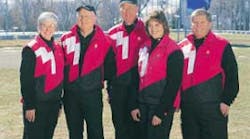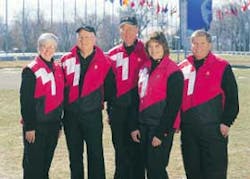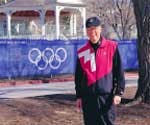By Kevin Henry
For 29 days, Dr. Lynn Powell and his team met the dental needs of the world's athletes
During the pageantry and competition that was the Games of the XIX Winter Olympics in Salt Lake City in February, the world was exposed to several acts of teamwork including the four-man bobsled, ice hockey, and speed skating relay. But there was one act of teamwork that was never seen on NBC that also played a critical role in the gold-medal aspirations of athletes from around the world.
Within the Olympic Village was a medical polyclinic, which was open 24 hours to the athletes and coaches, and within that polyclinic was a dental clinic, comprised of 14 dentists, three on-call specialists, and 12 dental assistants. All of these individuals volunteered to spend more than a month in Salt Lake City working at the Winter Games.
"The Salt Lake Olympic Committee (SLOC) put out an announcement for volunteers at the dental clinic two years ago, and hundreds of people sent in their applications," said Dr. Lynn Powell, who was responsible for organizing the Olympic dental clinic. "From a liability standpoint, we eventually decided to utilize the people from Utah who were licensed to practice in our state."
A year before the SLOC was sending out its notice for volunteers, it was notifying the University of Utah that it would be responsible for compiling the men, women, and machinery needed by the polyclinic and the dental clinic. With Dr. Powell as the head of the dental department, the responsibility for building the inside of the clinic from the ground up fell to him.
Yes, the SLOC provided the dental structure, but gathering the equipment, supplies, and manpower became a three-year project for Dr. Powell.
"When I first considered what I would be doing, I really didn't know what it meant or what was involved," Dr. Powell admitted. "I had no idea the extent of involvement we would need from manufacturers and volunteers. They presented me with numbers from past Winter Olympics of how many dental procedures were performed, but I looked at the numbers that were given, ranging between 50-425, and asked what those procedures entailed. Eventually, we had to guess at some things building up to the Olympics, based on our knowledge of past Winter Games and what might happen in Salt Lake City."
As it turns out, past numbers gave some indication of what Dr. Powell and his staff would see in Salt Lake City. Between Jan. 29 and Feb. 26, 311 appointments were made at the Olympic dental clinic. Included in those appointments were 490 panorex and intraoral radiographs, 178 composites, 46 amalgams, 132 oral exams, 48 endodontic teeth, and 22 extractions. There were also a number of other procedures that were simply listed as "other." Not surprisingly, a majority of the trauma procedures came from the hockey venue.
"One hockey player had an anterior bridge before the Olympics, but he took a puck in the mouth while he was here, which knocked the bridge completely out," Dr. Powell recalled. "We used a post and a custom core to replace the bridge and then fabricated a mouthguard to protect our work."
While the "other" procedures might have presented a challenge, so did the language barrier presented by the athletes who represented 78 delegations from around the world.
"Many times, we would have a patient in the chair and an interpreter standing by him or her," Dr. Powell said. "There were times that it took some extra time to explain a procedure to an interpreter, then have him or her try to explain it to the athlete before we could start."
While there were definitely some challenges involved with the dental clinic, getting the volunteers to perform as a team was not one of them, according to Dr. Powell. The 29 people who comprised the dental clinic staff came from a plethora of backgrounds, with some of them knowing others in the clinic and some bringing their own dental assistants to work the Olympics. Each person assigned to work in the clinic was asked to work a minimum of seven six- to eight-hour shifts between 8 a.m. and 8 p.m., as well as go through orientation and credentialing exercises as requested by the SLOC.
All SLOC volunteers were allowed to attend the dress rehearsal of the opening ceremonies and given tickets to some of the medal ceremonies and the associated entertainment. In addition, the International Olympic Committee (Medical Commission) was represented at the games by Dr. Paul Piccininni of Toronto, Canada and Dr. Rene Fasel of Zurich, Switzerland, who also wears the hat of president of the International Ice Hockey Federation. According to Dr. Powell, these men – who are also dentists – were very gracious in providing tickets in Dr. Fasel's box for the dental volunteers to attend ice hockey games at the E-Center.
While Dr. Powell is pleased with his Olympic experience, he is overjoyed with the cooperation shown by those who worked in the dental clinic.
"There was definitely some overlapping of shifts," Dr. Powell said. "I am just amazed that no one ever complained about any of the work involved with the Olympics. Looking back, I think the thing that I am most pleased about is that the volunteers did such a wonderful job working in the clinic and working together."
That mode of cooperation extended past the walls of the clinic to the many manufacturers who donated their goods to the dental clinic to help the athletes and coaches. The participating manufacturers included A-dec, Kodak, Instrumentarium Imaging, Air Techniques, Matrix, Dentsply, Ultradent Products, and Patterson Dental Supply.
"We could not have been successful without the manufacturers," Dr. Powell said. "There were so many that pitched in. All of the athletes and coaches who came to our clinic were provided with our services at no charge, and many manufacturers made sure that the SLOC and IOC (International Olympic Committee) could do this by giving of their equipment and materials at no charge."
The spirit of cooperation extended past the clinic as well, even as far as the Olympic Village security. In the aftermath of the September 11 tragedies, Dr. Powell and others were concerned about how tight security would be at the Olympics.
"The tighter security really didn't change what we were doing in the clinic. It only changed some procedures we had to go through to get to the clinic," Dr. Powell explained. "Our volunteers would come in wearing their uniform, would have to show their credential, and would have to be on the schedule for that day. We were a little concerned because we knew some of our schedules might change during the Games, but the security staff allowed us to notify them of a schedule change."
Changes were something that Dr. Powell saw a lot of in Salt Lake City leading up to the Games. After a 10-year stint on the faculty at the University of Washington, Dr. Powell moved to the University of Utah (located in Salt Lake City) in 1982. Since then, he has seen a city which has grown tremendously and prepared in earnest for one of the largest athletic competitions in the world.
"I think the biggest change has been the construction of the new venues and a complete reconstruction of a 26-mile stretch of freeway and several key side roads," Dr. Powell said. "I think it was more congested during that construction process than it was during the Olympics."
Now that the Olympics and Paralympics are over, Dr. Powell looks back on February and March with a degree of satisfaction in completing his task.
"After the Olympics and Paralympics were over, I was pleased to be able to get back to my regular duties, because the Olympics were really an addition to my normal responsibilities at the University of Utah," Dr. Powell said. "The one thing I'll never forget is the amount of cooperation given by dental manufacturers and the dentists and assistants who all went the extra mile without being asked.&quojt;
And, for that, Dr. Powell and his staff deserve a gold medal of their own.
Editor's Note: For more information, Dr. Powell can be reached at (801) 581-8951.
Those volunteering their time at the Olympic dental polyclinic included: Wally Brown, DDS, MS; Mark Cowley, DDS; Kelly Faddis, DDS; Brian Homer, DMD; Van Johnson, DDS; Shannon Lawson, DDS; Kent Linsley, DDS; Richard Martinez, DDS; Rand Mattson, DDS; Kyle Morgan, DDS; Steven Morgan, DDS; Craige Olson, DDS; G. Lynn Powell, DDS; Ron Shaw, DDS
On-call specialists included: Gregory Egbert, DDS, MS; Mark Mangelson, DDS, MS; Gerald Poulsen, DDS, MS
Assistants who worked in the dental polyclinic included: Betty Cowley, Julie Hicken, Sally Linsley, Terina Martinez, M. Shaun Moeller, Analee Morgan, Emily Morgan, Nici Nalder, Dianne Neibuhr-Joos, Debbie Preece, Michelle Shaw, Nicki Soffel
Note: Additional dentists participated at the ice hockey venue under the direction of the IHC.








